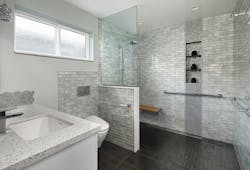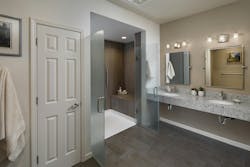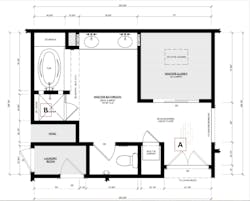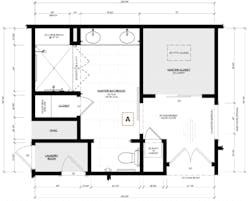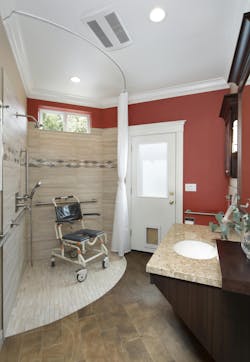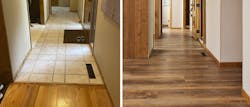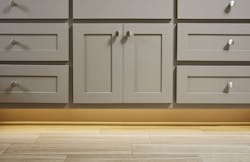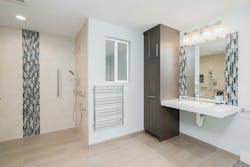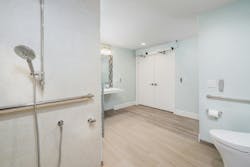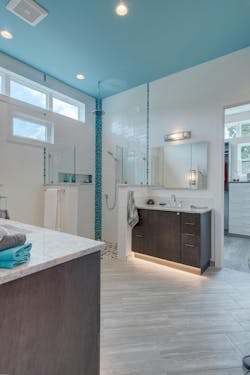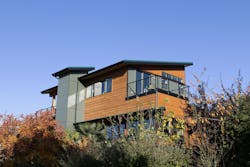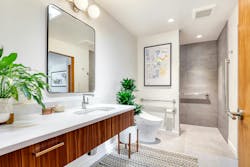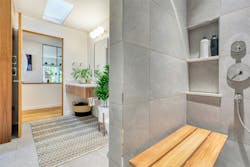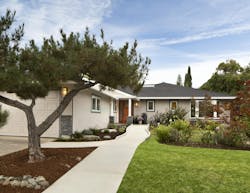Universal Design is Good Design and Great for Business
Universal design is a broad term that involves the craft of designing, remodeling, or building a home that’s usable, accessible, comfortable, and safe for people of all ages and abilities—without calling unnecessary attention to itself. And it’s a growing segment of the remodeling market that’s poised to only get bigger.
A survey of Pro Remodeler readers revealed that 77% of respondents had completed a remodeling or home improvement project related to universal design in the past 18 months, and 85% anticipated taking on such a project in the next 12-24 months. Additionally, 85% noted increased in interest in this type of remodeling work, and a significant 92% said they are actively seeking out these types of projects.
And do I need to point out that Baby Boomers continue to age and that other generations (here’s looking at you Gen X) are getting up there and will soon be in need of accessible homes if they aren’t already? And with mortgage rates staying high and housing inventory remaining low, many homeowners are staying put and hiring remodeling firms to create a “forever home” in which they can age in place.
In this section, learn about universal design best practices, see what makes a “forever home,” and read about the experiences, recommendations, and successes some remodelers have had in this segment.
Harrell Design+Build
Remodel Smart: Safety Starts in the Bathroom
Lisa Sten doesn’t like talking clients out of big, beautiful kitchen remodels that come with big, beautiful budgets, but she sometimes finds it necessary to do so. That’s because people can live with an outdated kitchen, but if their bathroom isn’t functional for them, that’s a big problem.
“We’ll say, you can redo your kitchen, but you're not going to be able to stay in your house if you don't do something about the bathroom,” Sten says. “Of course, we phase it in a different way and ask if they’re open to feedback because we have a suggestion.”
Sten is the CEO of Harrell Design+Build in Mountain View, Calif., and says that when a client’s goal is to stay in their homes, then a safe, accessible bathroom should be their first priority. “Often what they think they need and what they really need are two very different things,” she says.
Some of Sten’s clients are much more open to the idea of remodeling with universal design concepts in mind, while others are more hesitant to concede the need for accessible spaces. “I feel like the people in their 60s and 70s are more likely to say we need accessible things than the people in their 80s and 90s,” she says. "Maybe it’s because people saw what happened to their parents as they aged and how their home didn’t function for them, and thought, I'm not going to let that happen to me.”
Gloria Carlson, senior designer and sales manager at Harrell, thinks it also might have to do with perceptions of design. “Universal design of 10, 15, or 20 years ago could look really institutional and ugly, and I think that maybe scared some people away. They don't want to do it because they think it's going to look bad.”
Fortunately, design is at the heart of the universal design projects that Harrell undertakes, including some that won awards from the National Association of the Remodeling Industry (NARI).
Murphy Bros.
Inspiring Homeowners to Design for a Lifetime
When Murphy Bros. held its first “Forever Home” seminar, there was a good turnout. “We had around 14 people, which represented about nine households. We were pleased,” says Bob Mock, director of project development at the design-build firm serving the Twin Cities region in Minnesota.
Citing research that revealed 88% of seniors said it is important for them to stay in their home for as long as they can, the firm wanted to get potential clients to start planning for their future housing needs while they’re still in their 40s, 50s, or 60s. They developed a one-hour seminar organized around three topics: universal design remodeling, aging in place modifications, and financial planning.
“The forever home was our big umbrella, and under that was universal design and how the home works for all ages and all occupants, then we had the aging-in-place element and a specialist come talk about that, and then we had a certified financial planner talking about financing and how best to approach taxation and some of those other things,” says Mock.
The seminar is intended to attract clients looking for larger, transformational projects, such as multi-generational homes that work for everybody, or “legacy homes” (such as a family lake house that’s passed down to the children but still needs to accommodate aging parents), or additions to accommodate home health needs, or even an accessory dwelling unit. “The seminar is about so much more than grab bars,” says Mock.
What is a “Forever Home?”
A forever home is one that’s substantially transformed for the needs of not one generation, but many and that embodies the philosophies of universal design, according to Mock. Essentially, it’s just good design, which the firm refers to as architecture for staying put, that’s embodied in seven key principles:
- Equitable Use. Design that works for everyone, regardless of ability. Example: Think guests with mobility issues, a kid in a cast, or aging parents. A wide, no-step entry makes everyone feel welcome without drawing attention to anyone.
- Flexibility in Use. Accommodating a range of preferences and abilities. Example: Handheld showerheads and adjustable-height counters that don’t just serve people with disabilities but work great for both tall and short.
- Simple and Intuitive Use. Uncomplicated, self-explanatory design. Example: Lever-style handles instead of knobs. Touch-activated or motion-sensor lighting. Color-coded zones such as blue tile to define wet areas.
- Perceptible Information. Communicating essential information clearly. Example: Better lighting and contrasting colors on steps can help everyone, not just people with vision impairments.
- Tolerance for Error. Design that minimizes hazards and the consequences of mistakes. Example: Non-slip floors and anti-scald shower control. Safety should be baked into the design.
- Low Physical Effort. Design that can be used comfortably and efficiently with minimum fatigue. Example: Touchless faucets, soft-close drawers, and motorized blinds/shades.
- Size and Space for Approach and Use. Appropriate size and space for use regardless of body size, posture, or mobility. Example: Wide doorways (at least 36") and spacious clearances to accommodate a stroller, a walker, or a wheelchair; clear floor space in front of appliances and fixtures to allow seated or standing use.
Mock said the firm's seminar resulted in active discussions with two potential clients. And he’s committed to hosting future events and expanding the reach to different regions within the Twin Cities geography.
Irons Brothers Construction
Design with Empathy and Dignity
In 2011, Joseph Irons was in a bad motorcycle accident that required multiple surgeries. When he finally went home from the hospital, he was in a neck brace and using crutches. “Because of that, I have a lot of empathy when it comes to accessibility,” says Irons, president of Irons Brothers Construction, a design-build firm serving the north Seattle area.
Luckily for Irons, he had incorporated elements of universal design into the remodel of his own home soon after he had earned his Certified Aging-in-Place Specialist (CAPS) credentials through the National Association of Home Builders a few years before his motorcycle flew over a truck.
“I had lever handles so even though I was injured, I could bump the handle, push and get inside. I had a package shelf inside my house so I could set stuff down before going in, and I had motion-sensor lights [in some rooms] so I could open the door and the lights would already be on,” he says. Outside, he had relandscaped, adding concrete walkways so every entrance was accessible by wheelchair. But he notes, “It was still tough getting in and out of my giant bathtub.”
Irons says that around 60% of his remodeling projects involve some elements of universal design because a lot of clients are concerned about being able to age in place. “We're marketing more on aging in place this year than we ever have before, because that's a niche we’re working in all the time and we want to be known more for that than anything else,” he says.
And the firm is getting recognized for its work, taking home the Gold in the Aging In Place category in this year’s Best in American Living Awards (BALA) from the NAHB for their work creating a barrier-free primary suite in Shoreline, Wash.
Patience and Understanding
Talking about personal needs and diminishing abilities can be embarrassing for clients, says Irons, so he cautions remodeling professionals to exercise patience and understanding. “We’re dealing with someone’s private space, places they’re going to be naked in and we're talking with them about how they bathe, how they shower, how well they can take care of themselves,” he says. “People find it hard to admit they can't go to the bathroom or shower by themselves.”
And he notes the importance of being a great listener because sometimes people talk slower or can take longer to express what their actual needs are. And it critical to know who all the decision-makers are because you may not always deal directly with the client. “In some of these situations, we’re dealing with a trust officer or the client’s adult children or a sibling or other family member,” Irons explains.
Schulte Design Build
Making Room for Independence
The owners of this Mid-Century modern home in Seattle hired Schulte Design Build to remodel two bathrooms and the front entry to increase functionality and accessibility for their son who was in his early 20s and used a wheelchair.
The project won Gold in the Bathroom Remodeling over $50,000 category in this year’s Best in American Living Awards (BALA) from the NAHB for their work creating a modern ADA-bathroom remodel in Seattle.
“The house was a classic, really nice, so we had a great palette to work with,” says Joe Allper, production manager with Schulte Design Build. “The challenge really was the accessible bathroom, because we were very limited in how much we could change the footprint of the main bath. We did the best we could with the footprint we had.”
As with many remodels, things got more complicated during demolition when the team encountered structural deficiencies and found asbestos they hadn’t expected. “We found a point load to nowhere, so we had to pour a footing and put a column in, and it was not a minor thing,” says Allper. They also had to schedule asbestos abatement. “We usually know if we're going to get into hazmat, but this one had asbestos-backed flooring under an existing floor, so we could not have known.”
After more than 20 weeks, during which time the owners continued to live in the home, the project was completed and resulted in two very nice bathrooms (only the main one was designed to be ADA-compliant). The work also entailed widening the hallways and renovating the entryway for better accessibility.
Allper notes that he’s seeing more projects take accessibility into account. “Especially with the aging-in-place crowd, you get a lot of clients who want to be sure they can continue to use the home they love and say in the neighborhood they love,” he says.
However, he notes that the first conversation about this type of remodel can be disappointing because homeowners often think they can simply update an existing bathroom—and that’s not usually the case. “We're limited by what we can do unless we open up walls like we did here and really go all out,” says Allper. “But it is getting very common to have a conversation that starts off with ‘We want to live here a long time. What can you do to accommodate that?’,” he says.
Visitability: Is it Easy for People to Visit a Home?
Many remodeling projects that focus on accessibility are done so to accommodate the people living in the house. However, one element of universal design that’s growing in popularity is called visitability, and the term refers to designing a home so it is easily accessed by anyone—someone who has trouble with steps, uses a wheelchair or walker, or even someone who’s pushing a stroller.
The National Council on Independent Living defines a visitable home as one that meets three basic requirements:
- A zero-step entrance
- Doors with 32 inches of clear passage space
- A ground-floor bathroom that can accommodate a wheelchair
Lisa Sten, CEO of Harrell Design+Build in Mountain View, Calif., said her firm frequently works on projects for owners who need to make their homes accessible to everyone. These projects require level floors, the elimination of steps, and the incorporation of wider hallways. And the design can help future proof a home; if owners are young and fit, Sten says there’s still an advantage to having an accessible bathroom on the main level—it can be used by visitors and, in the future, by homeowners whose needs may change. She likes to locate an accessible bathroom close to a space (such as a home office) that can become a bedroom if needed.
In terms of entry access, Sten recommends a simple technique to gauge a home’s visitability and to help determine what changes are required: “Park your car at the house and take out a rolling suitcase and see how easy it is to get that suitcase from here to there to here to there,” she says. “It can be a big deal if you have to carry it up or down just one or two steps to get to the front door. Now, think about what that’s like for a person in a wheelchair.” And it’s not just the front door—for many homes, the garage is the main access point, so investigate the ability to get into and out of a car and then into the house. And don’t overlook lighting—there needs to be appropriate illumination for the driveway, walkways, steps, porches/decks, front door, and the entry hall. And consider illuminating the house number (a code requirement in some areas) so emergency responders can more easily locate the home.
Additional visitability tips listed outlined by the Harrell team:
Entryways: Entry doors should be a minimum of 36" wide and should have a peephole at an accessible level. There should be a beveled transition or low-profile threshold at the point of entry to allow easy passage of wheelchairs and other mobility devices. A bench or landing for placing bags while opening the door also is helpful.
Garages: If the garage is the primary entry point, eliminate clutter to create a clear path to get into and out of a vehicle as well as enter the residence. If the entry into the house from the garage has more than one step, a ramp or lift may be necessary.
Backyards & Garden Spaces: Remove any tripping hazards such as stepping-stones or uneven surfaces. Porches and decks should be enclosed with railings or large potted plants, both serving as a barrier against falling. If there is more than one step leading to a deck or other outdoor space, add a handrail for safety and accessibility. All hand and guardrails should be 42" high. (If the guardrail also serves as a handrail on stairs, it can be at 36" high.) The space between vertical railings must be no more than 4" wide.
CAPS: Certified Aging-in-Place Specialist credential program
The National Association of Home Builders offers the Certified Aging-in-Place Specialist (CAPS) credential program that focuses on training professionals on how to remodel homes so owners can comfortably and safely age in place and so they can meet the needs of people with disabilities.
The CAPS program consists of three courses:
- Marketing & Communicating Aging in Place Client (CAPS I)
- Design Concepts for Livable Homes and Aging in Place (CAPS II)
- Detail Solutions for Livable Homes and Aging in Place (CAPS III)
Once all three are completed, candidates can apply for their CAPS credential.
The Americans with Disabilities Act does not apply to private residences. However, remodelers often refer to ADA guidelines when working on accessible design projects. Key guidance for bathroom design includes:
Clear Floor Space: A minimum floor space measuring 30” x 48” is needed for wheelchairs to maneuver forward and parallel to fixtures.
Turning Space: A 60” diameter circle is recommended for wheelchairs to comfortably turn around.
Doorway: Doors should be at least 32” wide (when open 90 degrees) to accommodate wheelchairs.
Toilet: The toilet seat should be between 17” and 19” from the floor (consider a comfort-height toilet), and there should be 60” of clear floor space in front of the bowl for wheelchair access. Grab bars should be installed on the wall next to and behind the toilet.
Sink and Vanity: The sink should be mounted no higher than 34 inches so it’s accessible from a seated position, and there should be knee clearance underneath. Offset drains can provide more knee clearance.
Grab Bars: Installed at a height between 33” and 36” inches above the floor, and placed in showers, near toilets, and other areas where stability is needed.
Shower: Roll-in showers with seats are recommended and should have a minimum interior dimension of 60”x 30”.
Light switches and electrical outlets: Install within reach of a seated individual.
Door and faucet handles: Lever-style hardware is easier to operate than knobs.
Don’t overlook kitchens and laundry rooms
Bathrooms often get the majority of attention when talking about universal design and accessibility, but kitchens and laundry rooms need special features, too. Here are a few best practices provided by Harrell Design+Build and Murphy Bros.
Space planning
Leave a minimum of 48" between counters and include a 60" diameter open space to accommodate a wheelchair.
Provide space beneath the cooktop and the sink for individuals who use a wheelchair. Use a shallow sink and locate drains and garbage disposals toward the back of cabinet. Use a single-lever or motion-activated faucet and install it to the side of the sink for easier access.
Consider installing a pot-filler faucet or water source/drain adjacent to the cooktop.
Cabinets and counters
Use countertops at various heights (42”, 36”, 30”) to create different zones and to accommodate multiple users. Cabinets with interior pull-out drawers are better than those with shelves. Hardware should be pulls instead of knobs.
Specify non-reflective surfaces for countertops and use contrasting colors to better distinguish edges and changes in levels/surfaces.
Flooring
Install smooth, non-skid flooring surfaces with seamless transitions to minimize tripping hazards.
Appliances
Use induction cooktops that only heat the cookware; the surface itself never gets hot.
Choose a refrigerator with a freezer drawer on the bottom.
Install the microwave at a level accessible to those seated or standing.
Laundry
Specify front-load washing machines and dryers and install on raised platforms for better access.
Use utility sinks with clear knee space for seated users.
Electrical
Place outlets and switches on the face of cabinets and at levels that are reachable by those in seated positions.
Recessed or surface-mounted fixtures are ideal for overall illumination while under-cabinet task lighting should be installed at the front underside of cabinets.
About the Author
Jay Schneider
Senior Editor
Jay Schneider is the Senior Editor for Pro Remodeler. He can be reached at [email protected].
